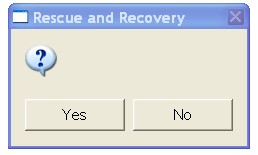Waterfire Photos


Labels: photos
Design, Management, Software, Consulting. By Lynn Cherny, Ph.D.


Labels: photos
Berkun posted an idle conversation starter on what he called "asshole-driven development" and the responses brought down his server. Then Lost Cog did some content analysis of the styles of development described by the comment thread. It seems to be going on and on. Some of the original categories identified:
As some posters and Scott noted, bad development management may be subtypes of general Management Antipatterns, like "Death by Planning."
And I'd note that these techniques aren't limited to management of technical problems, but also exist in any other project context, in slightly different forms.
Labels: management, tech
 And a friend sent a link to a great animation of a flash victim getting destroyed by the app. Lots of in-jokes for designers who use Flash, and hilarious anyway. You definitely want sound on for it.
And a friend sent a link to a great animation of a flash victim getting destroyed by the app. Lots of in-jokes for designers who use Flash, and hilarious anyway. You definitely want sound on for it.
Some highlights:
Labels: design, management
This said, I have seen the teamwork and normative workplace culture taken to extremes of unhealthiness, usually to the detriment of new hires with different ideas from other places. It's possible to be both infused with creative new ideas that threaten your status quo AND ship products, in my opinion. It's a challenge for mature management! To test your own culture: Check carefully how many managers, especially senior ones, were promoted from within versus hired externally. Then look at how experienced the people being hired are (sometimes, very). It might tell you something interesting about status quo thinking versus desire for fresh input.
Another test of your culture: In interviews, does the corporate "fit" come across as paramount, or the resume and evidence of work product elsewhere? I once watched a very senior statistician get turned down in favor of a more junior candidate who was just like everyone else in her skillset. I didn't fight hard enough myself on that one, I was part of the problem.
Defying authority certainly doesn't go over well in most corporate cultures I've worked in. Hierarchy is very much part of the American firm (Larry Prusack pointed this out recently at a great Boston CHI talk)-- the larger and more established the company, the more ingrained it is. I think there's a function related to size, corporate age, hierarchical position, and a person's tenure at a company that will predict how resistant she/he is to new ideas about doing things differently. Because large, successful companies are most reluctant to change what they do now (which is making money), for some sensible reasons: shareholders, golden handcuffs, employees to retain and feed, etc.
For designers, this often cashes out in how much change to an old shipping product you can make... a lesson it took me many jobs to really understand. (Note to designers hunting for jobs: Don't believe them when they say you're going to redesign it, especially if it's selling! The inertia will be strong and may become an actual undertow.) Historical success limits how much change you can make to processes that produced a selling product, even if they were flawed or painful in various ways for the people who worked on it. People are always more comfortable the way things are, regardless of what could be better.
Edited to add: It's a cultural failure mode to assume that everything is great or okay as is, but it's another one to fail to critically understand your successes, too. You can do root cause analysis for the good things too, and it might even teach you more than the failures do. If you aren't good at understanding success, you can't duplicate it, and you might make the critical morale error of celebrating the wrong factors.
Of all the weird ideas, the sensible-sounding "punish inaction" is particularly hard to see really happening in most offices. Few people are ever fired for not rocking the boat. People who aren't often noticed usually have a job for life, as long as their company keeps doing the same old expected thing.
Labels: management
I want a search agent that's heavily customizable to send me updates when certain things happen. What I specifically want is the ability to watch for fares of certain types to specific places FROM MY LOCAL AIRPORTS, or fares for vacation deals, again, FROM MY LOCAL AIRPORTS.
Sample criteria I want to have an agent look for:
PS. If someone wants to start this business, I'd be very motivated to help design it and to collect more requirements. Drop me a note.
Labels: travel
I get challenged occasionally as to why a seemingly well-educated, presumably rational person would be interested in the paranormal. I'm always a little surprised by this question: Why not? Do we know everything? Isn't it rational and intelligent to assume we don't yet? Remember, a UFO is just unidentified, it's not necessarily from another planet. It's interesting to me that there are so many worth talking about, and the stories people tell about them are interesting in themselves. I'm certainly open to believing in many things, while being a strong skeptic about what counts as good data and strong argument.
Another really entertaining collection, equally amateur web-design but much easier to use: The Photo Galleries of Mystery from the MMMGroup. Truly, if you like archaeological mysteries, this is the place to browse. Make sure you hit page two, too. It might make you wonder about time travel... The phenomenon of OOPARTS, or Out of Place Artifacts, is a strong feature of the pictures of rock carvings (people with lightbulbs, space suits...) and fossilized items. Here's a blog post about this type of find with particular reference to a find in 19th century Massachusetts, a metal fossil apparently blasted out of solid rock.
On the other hand, sometimes these things are explicit funny fakes; here's a guy who briefly got away with rock art depicting a caveman pushing a shopping cart in a British Museum Exhibit (2005).

Banksy also hung a sign saying the cave art showed "early man venturing towards the out-of-town hunting grounds". It read: "This finely preserved example of primitive art dates from the Post-Catatonic era. The artist responsible is known to have created a substantial body of work across South East of England under the moniker Banksymus Maximus but little else is known about him. Most art of this type has unfortunately not survived. The majority is destroyed by zealous municipal officials who fail to recognise the artistic merit and historical value of daubing on walls."
Labels: archaeology, weird
Fortunately, respect for this sort of parenting outside the board room is dwindling as baby boomers disappear from the parenting picture and Gen-Xers take their place. Sylvia Hewlett presents research to show that while baby boomers are willing to work extreme hours, younger people scoff at the idea of doing that for more than a year. And recent polls (via Hole in the Fence) show that men are sick of the long hours and want more time with their kids: Almost 40 percent of working dads would take a pay cut to spend more time with their kids. It'll be a great day when CEOs are dismissed for neglecting their kids. Meanwhile, employees, beware: CEOs like Stringer and Immelt have a negative effect on your own ability to keep your personal life intact, because work-life policy starts at the top and trickles down.
Amen. Some ways to figure out what the real corporate values around work-life balance are: Do people regularly have email exchanges on weekends or at strange hours of the night? (When you start a contract, do the execs welcome you via email sent on the weekend? :-) Who's still working at 7pm in the office?
Another point I'd add: How effective are they if they have that much to do, even at the office where they spend all their time? Executives at one of my past companies-- who praised it as an "aggressive" company with no ability to promise new hires good work-life balance and reasonable hours during their growth plans-- were themselves too busy to pay attention to many of the critical management issues that cross their desks! They're way past the tipping point on being good parents at the office, or good peers-- blowing off visiting VPs, even-- never mind what their wife and kids think of them for neglecting them! (This is, of course, my own opinion on them as seen from the middle management trenches, and may not be their own or their peers' opinions.)
Labels: management
Labels: weird